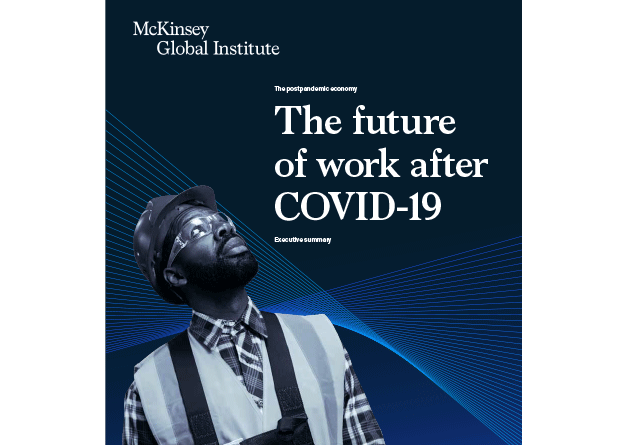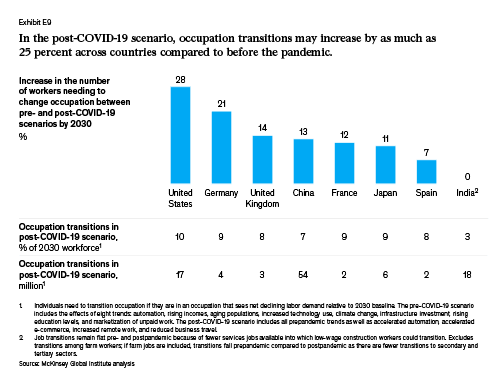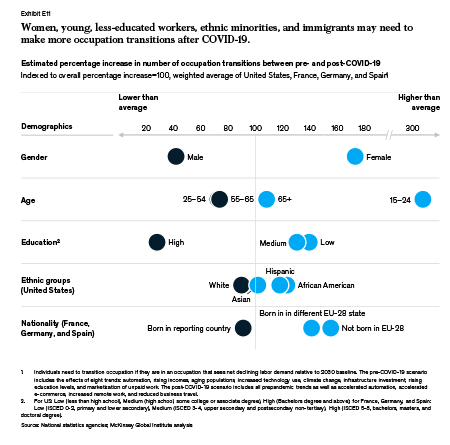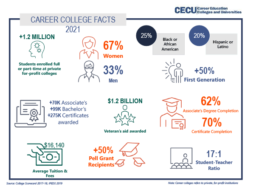
The Future of Work After COVID-19 Report
1 in 16 Will Need to Find a Different Occupation by 2030
By Sara Klein
“The future of work after COVID-19” by the McKinsey Global Institute, published in February, is the first of three reports that examine the post-pandemic economy. The report discusses the long-term displacement of workers due to COVID. Many of these frontline service workers who are being dislocated are the typical students at career colleges. The report raises awareness of the permanent changes in the labor force. Career schools are going to play a critical role in normalizing the labor market, which is an important point that the career school sector should be sharing with decision-makers and public officials.
The report examined the long-term changes COVID-19 may have created for the years ahead. There were eight countries studied, which included China, France, Germany, India, Japan, Spain, the United Kingdom, and the United States. “This report attempts to identify the lasting impact of the pandemic on labor demand, the mix of occupations, and workforce skills required, as well as the implications for business leaders, policymakers, and workers.”
Career colleges will be affected positively by the acceleration of work imperatives that businesses and policymakers are pushing for now.
Companies are taking the time to reimagine the work world after seeing the different ways that worked during the pandemic. “Speedy and effective worker redeployment will be needed, for example by recruiting and retraining based on skills and experience rather than academic degrees.”
Career colleges focus on skills training, so could be positively impacted by this new trend.
Digitization and automation are accelerated trends due to COVID. The report found that “Two to five times growth in e-commerce, as a surge in digital platforms is underway” and an “uptick in use of robotics, robotic process automation, and AI” have occurred due to COVID.
Another factor found by the report is that “business leaders and policymakers can build out digital infrastructure, enable faster reskilling, and innovate new worker benefits and support mechanisms.”
The research found that the pandemic has increased the importance of the physical dimension of work. “We find that jobs in work arenas with higher levels of proximity are likely to see greater transformation after the pandemic, triggering knock-on effects in other work arenas as business models shift in response.”
An area where career colleges will be increasingly important is in the area of training and skills-based occupations. “We estimate that more than 100 million workers in the eight countries studied may need to switch occupations, which is a 12% increase compared to before the pandemic overall and a 20% rise in advanced economies. These workers will face even greater gaps in skill requirements.” Career colleges can help these workers by training them in new skills for in-demand jobs.
Physical proximity has been highlighted as a factor shaping the future of work. “Before the pandemic, the largest disruptions to work involved new technologies and growing trade links, and a large body of academic research examined their impact on employment and jobs. COVID-19 has elevated the importance of a different aspect of work: its physical nature.” The report quantified different careers based on closeness to customers or coworkers, how often human interactions were required, whether the interactions were with a few people or many strangers, whether the work was inside, and whether on-site presence was necessary.
The work areas with higher physical proximity scores are going to be disrupted in the long term. Proximity is one explanation, although there are many.
One area is on-site customer interaction. This includes frontline workers who work with customers in retail stores, banks, post offices, and other places. Work in this arena includes frequent interaction with strangers and it also requires on-site presence. Many of these venues were shut down during the pandemic. “Some work migrated to e-commerce and ordering online, which is a behavioral change that is likely to stick.”
Another area is the leisure and travel arena. This includes customer-facing workers in hotels, restaurants, airports, and other entertainment venues. These workers interact daily with strangers and COVID-19 forced many to close, while airports and airlines operated on a limited basis.
“In the longer term, the shift to remote work and reduction in business travel, as well as automation of some occupations, such as food service roles, may curtail demand for work in this arena.”
In the computer-based office work arena, only moderate physical proximity occurred. What distinguishes this work area is that remote work was an easy transition, since most of the work doesn’t involve special equipment or in-person customer interactions. “This is the largest work arena in advanced economies, accounting for roughly one-third of employment. Nearly all potential hybrid remote work is within this arena.”
The area that COVID-19 had a relatively limited impact on was the outdoor production and maintenance arena, which includes construction sites, farms, and other outdoor spaces. “Work here requires low proximity and few interactions with others, and it takes place fully outdoors.”
Some of the COVID experiences are likely to continue, even after the pandemic ends. One such experience is remote work and virtual meetings. “That experience proved some of the benefits of remote work, including greater flexibility for workers and more efficiency for businesses. How much will stick is uncertain, but employers and employees who can work from home agree that remote work – at least for part of a workweek – is here to stay.” Some work, though, which technically could be done remotely, was much better if done in person. One example of this is schooling. Online schooling was fine in the emergency, but its effectiveness was a lot less, especially with students with disabilities and younger kids. Some other examples of work that is better in person includes “negotiations, critical business decisions, brainstorming sessions, providing sensitive feedback, and onboarding new employees.”
Although not all work arenas can effectively work from home three to five days a week, and they are in fact in the minority, these arenas have seen a dramatic increase since the pandemic, with four to five times more remote work occurring. This has a ripple effect on the business world in general, with major implications for urban centers. “Demand for restaurants and retail in downtown areas and for public transportation may decline.” Some offices are reducing their spacing needs because of the flexibility of the workweek, which will impact office buildings.
Also, there could be a shift from working in big cities to the suburbs and smaller cities with this increase in remote work. The study found that residential renting in the United States shows people moving away from urban centers.
“The results show that major metropolitan areas, such as New York City, the San Francisco Bay Area, Washington, DC, and Boston had the greatest decline in inflow-outflow ration of members, while smaller cities such as Madison, WI; Jacksonville, FL; and Salt Lake City had the greatest growth.”
The report also noted that a decline in work travel may be a result of the pandemic, due to the extensive use of videoconferencing which has brought a new acceptance of virtual meetings. This may replace some business travel in the future. The report estimates “that about 20% of business travel may not return after the pandemic. This would have a significant knock-on effect on employment in commercial aerospace and airports, hospitality, and food service.”
While some industries will decrease, others will have the chance to increase. E-commerce and other virtual arenas are growing, which is increasing the demand for work in that arena. Many people learned about the convenience of these services during the pandemic and will continue to use them. “In 2020, the share of e-commerce in retail sales grew at two to five times the rate before COVID-19, increasing its share of total retail sales by several multiples. Three-quarters of people using digital channels for the first time during the pandemic say they will continue using them when things return to normal.”
An example of the increase of automation adoption, is the surge in demand required more use of these technologies. “Our research suggests that faster adoption of automation, AI, and digital technologies is likely to be concentrated in specific use cases, reflecting company priorities related to COVID-19.” Automation also includes the cases of high human interaction, which includes physical closeness to others, a high frequency of interactions, and the level of exposure to strangers. The research suggests that the areas that have the highest levels of human interaction are also going to see the highest increase in automation and AI.
Digital interactions have risen pretty much in every work arena, even those with high social interaction. Two areas will have the highest rate of adoption, which include “on-site customer interaction, fueled by the rise of e-commerce and food delivery, and computer-based office work where use of digital collaboration tools and digital channels has spiked.” Medical care has used much more telemedicine and education has used many more digital devices like laptops.
Low-wage occupations will not see much job growth and the mix of occupations in the economy is going to shift.
Before the pandemic, low-wage workers who lost their jobs moved to other low-wage occupations. Now, with the trends moved up with COVID-19, “we estimate that to remain employed, more than half of the low-wage workers currently in declining occupations would need to shift to occupations in higher wage brackets that require different skills.” This will directly affect career colleges, who do the majority of the training in these skills.
The largest negative impact of the pandemic affects workers in food service and customer sales and service roles, and the demand for workers increased in healthcare and STEM occupations. “Looking at changes in occupations across countries, a common trend is apparent: Declines in net job growth are likely to concentrate in low- and middle-wage positions, such as customer service jobs in retail, hospitality and food service, while net job creation may occur primarily in high-wage jobs, such as health care and STEM.”
 The retraining of workers who have to switch occupations (up to 25%) may be more difficult, but it is something the career colleges can help with and get behind. According to the research in the report, the concentration of job growth will increase in high-wage occupations and decrease in low-wage occupations, resulting in workforce transitions. “Across the eight countries, 107 million workers, or 1 in 16, will need to find a different occupation by 2030 in our post-COVID-19 scenario.” This is 12% more than was estimated before the pandemic.
The retraining of workers who have to switch occupations (up to 25%) may be more difficult, but it is something the career colleges can help with and get behind. According to the research in the report, the concentration of job growth will increase in high-wage occupations and decrease in low-wage occupations, resulting in workforce transitions. “Across the eight countries, 107 million workers, or 1 in 16, will need to find a different occupation by 2030 in our post-COVID-19 scenario.” This is 12% more than was estimated before the pandemic.
The workers needing to transition to different jobs will require training and new skills. “Not only a larger share of workers will likely need to transition out of the bottom two wage quintiles but also a majority of them will need new, more advanced skills to move to occupations that are one or even two wage quintiles higher.”
Workers with less than a college degree, members of minority groups, and women are the groups who are more likely to need to change occupations. “In the United States, people without a college degree are 1.3 times more likely to need to make transitions compared to those with a college degree, and Black and Hispanic workers are 1.1 times more likely to have to transition between occupations than white workers.”
 With businesses reimagining where and how work is done, this increases reskilling efforts. Many employers actually are trying to create hybrid remote working strategies for a variety of reasons, including “expanding access to talent, increasing employee satisfaction, and reducing real estate costs.” Another change businesses are making could include changes in hiring practices, which will focus more on the potential employee’s skills rather than a degree, which will increase the candidate pool and help companies become more diverse. “Google, Hilton Hotels, Ernst & Young, and IBM are among a growing number of employers that have changed job postings to remove degree requirements and focus on skills; they have seen marked increases in new hires without college degrees for some roles.”
With businesses reimagining where and how work is done, this increases reskilling efforts. Many employers actually are trying to create hybrid remote working strategies for a variety of reasons, including “expanding access to talent, increasing employee satisfaction, and reducing real estate costs.” Another change businesses are making could include changes in hiring practices, which will focus more on the potential employee’s skills rather than a degree, which will increase the candidate pool and help companies become more diverse. “Google, Hilton Hotels, Ernst & Young, and IBM are among a growing number of employers that have changed job postings to remove degree requirements and focus on skills; they have seen marked increases in new hires without college degrees for some roles.”
Another focus for business and policymakers is the digital infrastructure, which helps support workers in transition. “Expanding digital infrastructure is important, given the pandemic-fueled boost to the online economy … In the United States, McKinsey research found that learning losses from the pandemic could wipe out the equivalent of one year of salary on average – and more for underrepresented ethnic groups.”
The report focused on training and lifelong learning, a factor that will directly impact career colleges, who will be doing much of this training. “In an era in which mid-career workers may need to retrain and switch occupations, and during which lifelong learning may become a reality rather than just a catchphrase, new or expanded forms of income support could help ease the transition.”
Workers will need to have licensing and certification requirements to make sure they have the proper skills and training in their profession, but one of the issues is it can limit competition and mobility.
“During the pandemic, for instance, several US states and the federal government eased scope-of-practice restrictions on nurse practitioners and doctors to enable them to care for COVID-19 patients.”
The article concluded with a discussion on how the impact of the pandemic on work with high physical proximity shocked the workforce, which will continue to influence it in the years to come.
To read the full report go to https://www.mckinsey.com/featured-insights/future-of-work/the-future-of-work-after-covid-19
About McKinsey Global Institute:
The McKinsey Global Institute (MGI), founded in 1990, considers its mission to “develop a deeper understanding of the evolving global economy.” Using analytical tools and research combining economics and management disciplines, they use a micro-to-macro approach to “examine microeconomic industry trends to better understand the broad macroeconomic forces affecting business strategy and public policy.” These reports, which have covered more than 20 countries and 30 industries, focus on six themes: “productivity and growth, natural resources, labor markets, the evolution of global financial markets, the economic impact of technology and innovation, and urbanization.” MGI is led by three senior partners and has a council made up of 13 McKinsey leaders, who create the research agendas, lead the research, and share the findings with decision-makers. For more information, please visit www.mckinsey.com/mgi.










